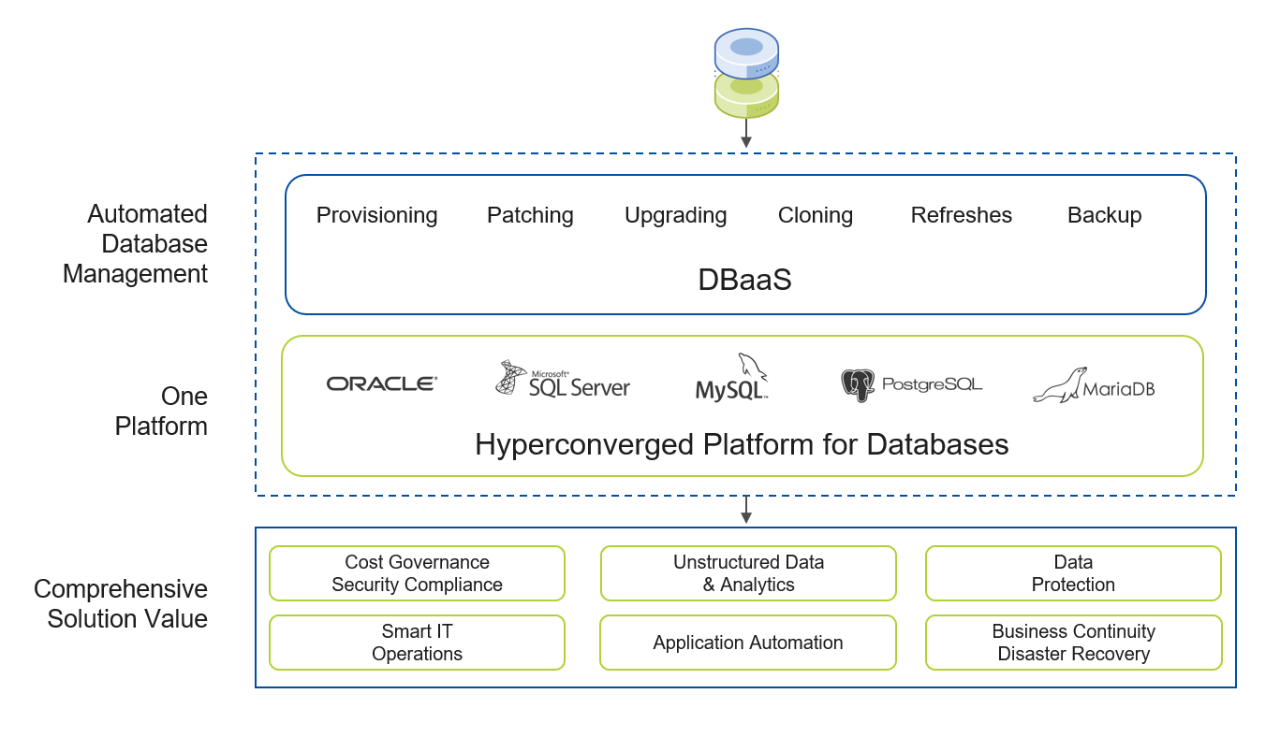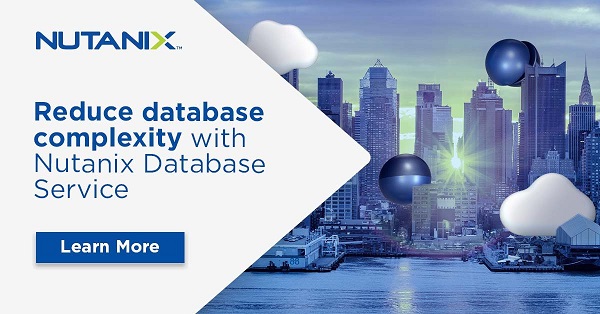Organizations are crunching more data by the day in an attempt to drive innovation, improve customer experience and leave the competition behind. This can be sustained only with tech-driven, astute approaches to data management and deployment of infrastructure that matches their data collection and processing needs.
Enterprises the world over are moving in this direction by adopting hybrid, multicloud strategies to use and manage their data and workloads. That said, while many IT processes, applications and services have been positively impacted and simplified by automation and data virtualization, databases and database administration practices haven’t kept up.
In today’s enterprises, services and applications frequently run across hybrid IT architectures consisting of on-prem data centers and multiple public and private clouds. This makes the prospect of modernizing databases optimized for legacy infrastructure daunting. Moving them to the cloud is downright scary.
As business models evolve, there is a dire need for database models that keep up with the pace of data creation while dealing with raw and unstructured data formats. The number and types of databases (including relational, non-relational, open source, wide-column, key-value, graph, time series, cloud-based, search engine, in-memory, spatial, document, multi-model, and so on) continue to grow, leading DBAs and IT leaders to look for flexibility, interoperability, simplicity, mobility and reliability. There is an urgent need for upgrading legacy database platforms and scaling storage infrastructure without disrupting routine database operations.
“Customers want to reduce the risk, effort and cost of operating their database fleets, which typically consist of thousands of databases,” said Jeremy Launier, Sr. Director of Product Management at Nutanix. “They want to run both proprietary and open-source databases. They want to enable developers to use databases without bothering DBAs. They want to retain full control of their database servers. They need to do all of this while having the flexibility to run on their cloud of choice, in the most cost-effective environment that meets business requirements for a given set of applications, in a given region, and at a given consumption level.”
Might be easier to fit the Hulk into a baby stroller and make him comfortable, wouldn’t it?
The key, according to Launier, is removing complexity, speeding up database provisioning and providing self-service capabilities to application developers. Enter the world of distributed cloud databases – collections of operational datasets housed across multiple physical locations including on-prem data centers, hybrid or multicloud environments.
Database Management In The Hybrid Cloud
More and more organizations are finding that using cloud-based tools and solutions for database operations maximizes resource utilization, reduces TCO and improves agility. These facilitate the creation of smart datasets and fulfil the promise of big data.
The hybrid cloud approach involves divvying up datasets intelligently among the private and public components of a hybrid or multicloud environment. This means putting business-critical data in a private cloud for optimal security and granular access and non-critical or archival data in the public cloud for quicker and more general access.
Hybrid cloud platforms offer a single, unified control plane for administration of multiple databases, while ensuring the three core best practices of data management:
- Data virtualization: Applications and users can access and manipulate data without needing meta data on its physical location or format
- Data gravity: Data, records and files aren’t moved around unless absolutely necessary – instead, workloads are pushed to where data is stored
- Single source of truth: Copies of data are minimized to bare necessities, data entropy is eliminated and everyone accesses the same data from a single source
“Hybrid cloud databases have enormous business benefits for companies because they allow a company to run the database where the business and data dictates, rather than where the technology dictates,” said Neil Carson, CEO of Yellowbrick Data. “This allows companies to observe data gravity or sovereignty requirements, accommodate multicloud architectures and get the performance of on-premises systems in conjunction with the scale of a cloud.”
The Road To DBaaS Passes Through HCI
When it comes to database deployment and management in a hybrid cloud environment, complexity is the elephant in the room. Modern applications frequently access multiple databases, often simultaneously. This is common in cloud-native applications built from microservices. Then, there are function-specific databases built for accessing streaming data or in-memory analytics; these often co-exist in one cloud or the other with traditional, relational engines.
This has led to the rise of Database-as-a-Service (DBaaS), a cloud-based approach that enables admins to set up, operate and scale databases without going into the details of each implementation. It involves a single console and API for provisioning, management and declarative administration – the owner simply specifies the desired end state and the system configures itself to match it.
However, DBaaS in its current form does have a few limitations, especially in adapting to legacy databases that weren’t designed to scale out. Further, moving some databases to the cloud isn’t an option in the first place. Organizations operating in regulated industries such as finance, telecom and healthcare may be required by law to store data on-prem or within a specific region. Others prefer an on-prem database that helps retain ownership rights, security and control.
This gap is bridged by hyperconvergence. Hyperconverged infrastructure (HCI) binds traditional architecture with cloud ops to virtualize database infrastructure irrespective of the underlying engine. It provides software-driven control of database workloads, pooling and allocating storage, networking and compute resources as needed along with linear scaling on-demand. With its ability to work on-premise, in the cloud, or in a hybrid setup, HCI lays the groundwork for advanced DBaaS applications.
Nutanix’s own hybrid cloud platform for databases, called Nutanix Database Service, enables nimble IT teams to operate and manage large fleets of databases across a hybrid environment using a single console and API.

“Nutanix’s key differentiator is that it does not limit customer database choices,” Tony Baer, a recognized industry expert in databases, cloud and data analytics, said in a 2020 interview with The Forecast.
He said most commercial DBaaS services are designed around specific databases, but Nutanix allows customers to “take advantage of the benefits of DBaaS with the databases of their choice.”
Further, the Nutanix Database Service offers one-click provisioning, patching, snapshots, backup, and upgrades across all major database engines including Oracle, MySQL, SQL Server, MariaDB, PostgresSQL and SAP HANA.
“IT and the business are the beneficiaries,” Baer explained. “IT, because it can devote its efforts to higher value-added tasks, and the business, because they can reduce time to benefit and grow more agile in response to changes in their competitive landscapes.”
Less Complexity
Database management has always been a time- and resource-intensive process. It shouldn’t come as a surprise that it is the only IT function that needs an “database administrator” position other than “system/network administrator.” If a hybrid cloud-database combo succeeds in freeing up time spent in admin work, it could be productively channeled towards performance optimization, innovation or strategic objectives.
DBAs at RBL Bank, one of India’s top rated mid-sized banks and a leader in the digital space, were constantly playing catch-up with routine maintenance tasks. Primary among these was user acceptance testing (UAT), which took up 70% of their time. RBL Bank went for a database, end-user computing (EUC) and HCI solution from Nutanix, post which they pared the time spent on UAT right down to 30%.
“I’ve never had it before where one administrator can do everything – database set up, virtual machine set up, and platform management,” said Nimish Valia, Head of Center of Excellence, Strategic Technologies at RBL Bank.
“I had to figure out how to re-allocate the staff from our infrastructure teams. It was a great issue to have.”
Better Performance
Provisioning is one of the biggest areas where traditional DBMSs such as Oracle and Microsoft SQL Server lag behind modern cloud database services. RBL was able to bring down their database provisioning time by nearly 90%. As a result, they were able to create zero-byte DB clones in less than four hours, which in turn speeded up their time-to-market from 2-4 days to 4-6 hours.
Another example is that of Danish publisher Gylendal, who consolidated 350 databases distributed over 40 server instances onto a single Microsoft SQL cluster as part of their Nutanix Enterprise Cloud implementation, leading to a 5x improvement in SQL Server performance. This was on top of a flash solution with NVMe acceleration, which was already in place, enabling them to get the best out of their storage infrastructure.
Business Continuity
The pandemic taught every business in the world an unforgettable lesson: Staying open for business 24x7 is what separates the great from the insolvent. Healthcare provider Delaware Valley Community Health (DVCH) saw a 90% acceleration in login times directly attributable to database performance when they migrated their databases and applications to a Nutanix-powered hybrid solution.
Backup and disaster recovery (DR) is the nucleus of business continuity and availability. DVCH was able to accelerate database replication to a point where recovery times came down from 24-48 hours to a mere six minutes. That’s not all, TB-level backups that took 4-6 hours on average were done in 30 minutes and could be scheduled during the day instead of night.
As COVID-19 surged in waves, DVCH was able to shift three quarters of its 300+ workforce to WFH in a matter of days. “If you can’t provide the technology your workforce requires, they can’t work,” said Isaiah Nathaniel, CIO of DVCH. “I’m extremely proud of the fact we haven’t laid a single person off and have been able to fully fund our entire workforce. If we didn’t have a system in place that enabled us to continue our business, I don’t know where we would be.”
Hybrid All The Way
The global market for database management systems is projected to hit a mind-boggling $142 trillion by 2027. IT teams will spend significant time and effort in deploying and managing databases for cloud workloads. And yet, cloud databases remain very hard to implement – complexity grows with the number of platforms involved, security becomes a concern when data moves through public networks, newer code doesn’t always work with legacy systems as expected, flexible service providers aren’t easily found, and so on.
Nevertheless, the flexibility, reliability and ROI make hybrid solutions worthwhile for the organization sooner rather than later. Even middle-of-the-road, HCI-driven hybrid solutions can lower both CAPEX and OPEX for databases, ultimately reducing database TCO by an average of 62% across deployments.
“The majority of workloads go through a lifecycle,” said Launier. He explain how they start in the public cloud when resource consumption is low, but as volume and requirements scale up, so do costs.
“That's where we see some applications and associated databases move back to a more cost-effective environment, such as on-premises data centers and colocation sites. The result is a truly hybrid mutlicloud architecture, with apps and databases running across on-prem, colo sites, and one or more public clouds.”
And this constant flux is what makes rethinking database management and operations a necessity in 2022.
Editor’s note: Learn more about Nutanix solutions for database deployments. Read the case study with East Coast AAA and Sakra World Hospital.
Dipti Parmar is a marketing consultant and contributing writer to Nutanix. She’s a columnist for major tech and business publications such as IDG’s CIO.com, Adobe’s CMO.com, Entrepreneur Mag, and Inc. Follow Dipti on Twitter @dipTparmar or connect with her on LinkedIn for little specks of gold-dust-insights.
© 2022 Nutanix, Inc. All rights reserved. For additional legal information, please go here.






